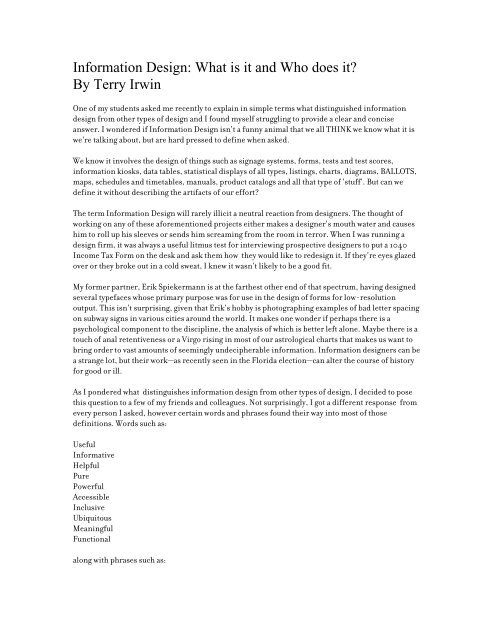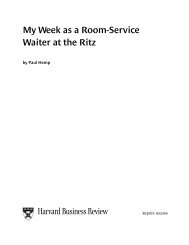Information Design: What is it and Who does it? By Terry Irwin
Information Design: What is it and Who does it? By Terry Irwin
Information Design: What is it and Who does it? By Terry Irwin
You also want an ePaper? Increase the reach of your titles
YUMPU automatically turns print PDFs into web optimized ePapers that Google loves.
<strong>Information</strong> <strong>Design</strong>: <strong>What</strong> <strong>is</strong> <strong>it</strong> <strong>and</strong> <strong>Who</strong> <strong>does</strong> <strong>it</strong>?<strong>By</strong> <strong>Terry</strong> <strong>Irwin</strong>One of my students asked me recently to explain in simple terms what d<strong>is</strong>tingu<strong>is</strong>hed informationdesign from other types of design <strong>and</strong> I found myself struggling to provide a clear <strong>and</strong> conc<strong>is</strong>eanswer. I wondered if <strong>Information</strong> <strong>Design</strong> <strong>is</strong>n't a funny animal that we all THINK we know what <strong>it</strong> <strong>is</strong>we're talking about, but are hard pressed to define when asked.We know <strong>it</strong> involves the design of things such as signage systems, forms, tests <strong>and</strong> test scores,information kiosks, data tables, stat<strong>is</strong>tical d<strong>is</strong>plays of all types, l<strong>is</strong>tings, charts, diagrams, BALLOTS,maps, schedules <strong>and</strong> timetables, manuals, product catalogs <strong>and</strong> all that type of 'stuff'. But can wedefine <strong>it</strong> w<strong>it</strong>hout describing the artifacts of our effort?The term <strong>Information</strong> <strong>Design</strong> will rarely illic<strong>it</strong> a neutral reaction from designers. The thought ofworking on any of these aforementioned projects e<strong>it</strong>her makes a designer's mouth water <strong>and</strong> causeshim to roll up h<strong>is</strong> sleeves or sends him screaming from the room in terror. When I was running adesign firm, <strong>it</strong> was always a useful l<strong>it</strong>mus test for interviewing prospective designers to put a 1040Income Tax Form on the desk <strong>and</strong> ask them how they would like to redesign <strong>it</strong>. If they're eyes glazedover or they broke out in a cold sweat, I knew <strong>it</strong> wasn't likely to be a good f<strong>it</strong>.My former partner, Erik Spiekermann <strong>is</strong> at the farthest other end of that spectrum, having designedseveral typefaces whose primary purpose was for use in the design of forms for low-resolutionoutput. Th<strong>is</strong> <strong>is</strong>n't surpr<strong>is</strong>ing, given that Erik's hobby <strong>is</strong> photographing examples of bad letter spacingon subway signs in various c<strong>it</strong>ies around the world. It makes one wonder if perhaps there <strong>is</strong> apsychological component to the d<strong>is</strong>cipline, the analys<strong>is</strong> of which <strong>is</strong> better left alone. Maybe there <strong>is</strong> atouch of anal retentiveness or a Virgo r<strong>is</strong>ing in most of our astrological charts that makes us want tobring order to vast amounts of seemingly undecipherable information. <strong>Information</strong> designers can bea strange lot, but their work—as recently seen in the Florida election—can alter the course of h<strong>is</strong>toryfor good or ill.As I pondered what d<strong>is</strong>tingu<strong>is</strong>hes information design from other types of design, I decided to poseth<strong>is</strong> question to a few of my friends <strong>and</strong> colleagues. Not surpr<strong>is</strong>ingly, I got a different response fromevery person I asked, however certain words <strong>and</strong> phrases found their way into most of thosedefin<strong>it</strong>ions. Words such as:UsefulInformativeHelpfulPurePowerfulAccessibleInclusiveUbiqu<strong>it</strong>ousMeaningfulFunctionalalong w<strong>it</strong>h phrases such as:
The form <strong>is</strong> the contentIt <strong>does</strong>n't sell you something you don't needIt's not decorativeIt's not subjectiveIn the h<strong>and</strong>s of the wrong people <strong>it</strong> can have d<strong>is</strong>astrous effectsIt's often poorly doneIts potential for good <strong>is</strong> matched in equal proportion to <strong>it</strong>s potential for creating confusion or harmNot shiny, but essentialIt's the underwear, not the tiara (sounds like a Tom Wa<strong>it</strong>s song)It's the soup stock not the spiceForm must follow functionThe following are among some of the attributes l<strong>is</strong>ted on the home page for The Inst<strong>it</strong>ute for<strong>Information</strong> <strong>Design</strong> or IIIDAn information designer:• must be able to think both innovatively <strong>and</strong> systematically• must be highly knowledgeable about the subject area they are working in• must be knowledgeable about the communicative aspects <strong>and</strong> interrelationships of the componentsof the message• must underst<strong>and</strong> the relevant customs, conventions, st<strong>and</strong>ards, <strong>and</strong> regulations associated w<strong>it</strong>h themessage• must be familiar w<strong>it</strong>h human communication capabil<strong>it</strong>ies w<strong>it</strong>h regard to perception, cogn<strong>it</strong>iveprocessing <strong>and</strong> multi-sensory responses• must underst<strong>and</strong> the potential benef<strong>it</strong>s to users of the information being communicated• must be able to give form to information that <strong>is</strong> both attractive <strong>and</strong> functional• must design for systems that need to comply w<strong>it</strong>h ever-changing requirements <strong>and</strong> guidelines thatmust be easily updated <strong>and</strong> changed• <strong>Information</strong> designers must be able to communicate effectively in both their mother tongue <strong>and</strong>Engl<strong>is</strong>h• must underst<strong>and</strong> the capabil<strong>it</strong>ies of support sciences such as cogn<strong>it</strong>ive psychology, lingu<strong>is</strong>tics, social<strong>and</strong> pol<strong>it</strong>ical sciences, computer science, <strong>and</strong> stat<strong>is</strong>tics; <strong>and</strong> be able to work w<strong>it</strong>h special<strong>is</strong>ts in theseareas to design effectively for cultural differences• must behave in a responsible manner w<strong>it</strong>h regard to the needs of the target users <strong>and</strong> society as awhole.(I'm betting most of us didn't realize we were doing all of that)
In add<strong>it</strong>ion to these attributes I would add:• must posses a rigor in thinking• an innate curios<strong>it</strong>y• street smarts & savvy• empathy• a love of details• a love of clar<strong>it</strong>y• an interest <strong>and</strong> underst<strong>and</strong>ing of multi-cultural <strong>is</strong>sues• a willingness to get their h<strong>and</strong>s dirty<strong>and</strong> if not a requ<strong>is</strong><strong>it</strong>e qual<strong>it</strong>y, then certainly a character<strong>is</strong>tic of many information designers <strong>is</strong>:• a desire to help people<strong>Information</strong> <strong>Design</strong>ers are very special people who must muster all of the skills <strong>and</strong> talents of adesigner, combine <strong>it</strong> w<strong>it</strong>h the rigor <strong>and</strong> problem solving abil<strong>it</strong>y of a scient<strong>is</strong>t or mathematician <strong>and</strong>bring the curios<strong>it</strong>y, research skills <strong>and</strong> doggedness of a scholar to their work. I think they're theunsung <strong>and</strong> often unnoticed heros of our profession.About the author:<strong>Terry</strong> <strong>Irwin</strong> <strong>is</strong> a design consultant <strong>and</strong> educator working w<strong>it</strong>h businesses <strong>and</strong> design schoolsthroughout the country. In 1992, along w<strong>it</strong>h partners Bill Hill <strong>and</strong> Erik Spiekermann, <strong>Terry</strong> openedthe San Franc<strong>is</strong>co office of Meta<strong>Design</strong>, an international design firm w<strong>it</strong>h offices in Berlin, Zurich,<strong>and</strong> London where she served as Principal <strong>and</strong> Creative Director until October of 2001. While there,<strong>Terry</strong> directed projects for clients such as Sony, IBM, The Getty Museum, Palm Computing, AppleComputer, Bank of America <strong>and</strong> The Nelson-Atkins Museum of Art <strong>and</strong> collaborated w<strong>it</strong>h both theBerlin <strong>and</strong> London offices of Meta<strong>Design</strong> on international projects for Audi <strong>and</strong> Wells Fargo Bank.Prior to opening Meta<strong>Design</strong>, <strong>Terry</strong> worked as a Project Director for L<strong>and</strong>or Associates <strong>and</strong> Anspach,Grossman Portugal in San Franc<strong>is</strong>co.<strong>Terry</strong> has served as a member of the faculty for Ot<strong>is</strong> Parsons School of <strong>Design</strong> in Los Angeles, The ArtAcademy of San Franc<strong>is</strong>co <strong>and</strong> has been an adjunct Professor at California College of Arts <strong>and</strong> Craftssince 1989. She has guest lectured <strong>and</strong> taught seminars at both the undergraduate <strong>and</strong> graduate levelsat: North Carolina State Univers<strong>it</strong>y, Ohio State Univers<strong>it</strong>y, The Rhode Isl<strong>and</strong> School of <strong>Design</strong>, ArtCenter, Washinton State Univers<strong>it</strong>y <strong>and</strong> Carnegie Mellon Univers<strong>it</strong>y. <strong>Terry</strong> completed her graduatestudies at the Basel School of <strong>Design</strong> in Sw<strong>it</strong>zerl<strong>and</strong>. She lives in Mill Valley w<strong>it</strong>h an extraordinaryBoston Terrier named Max.



